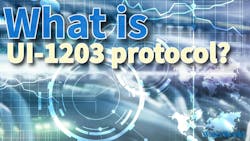In an increasingly interconnected water utility landscape, communication is everything. Behind the scenes of modern water meter reading systems—whether it’s a technician in the field, a truck collecting drive-by readings, or fully-automated Advanced Meter Infrastructure (AMI) capturing data in real time—lies a common language that makes all this possible. That language is the UI-1203 communication protocol.
Though it may sound highly technical, UI-1203 is simply a standardized way for water meters and the devices that read them to talk to each other. Its adoption across manufacturers and systems has helped create a more open and flexible environment for utilities, allowing components from different vendors to integrate smoothly. Whether you’re new to the water utility industry or a seasoned pro encountering this term for the first time, this article will help you understand what UI-1203 is, how it works, and why it matters.
The basics: What is UI-1203?
At its core, UI-1203 is a data communication protocol—a set of rules for how digital information is exchanged between water meters and external devices like radio transmitters, electronic displays, and AMR/AMI systems. The American Water Works Association (AWWA) has adopted this protocol as an industry standard.
This standardized protocol enables encoded meter registers and digital outputs from today’s modern ultrasonic meters to communicate consistently and reliably with meter reading technologies, regardless of brand. That means a utility can use equipment from different manufacturers without worrying about incompatibility or the need for complex field programming.
Technical deep dive: How it works
While not overly complex, UI-1203 does feature some distinctive characteristics that differentiate it from more traditional serial communication methods. Here’s what makes it unique:
Communication format
- Synchronous communication: Unlike common serial ports that use asynchronous signaling, UI-1203 operates synchronously. That means it uses a clock signal to time the transmission of data, making the communication more predictable and reliable.
- ASCII encoding: Data is transmitted in ASCII (American Standard Code for Information Interchange) format. This ensures that data—like meter readings and ID numbers—is transmitted in a readable, standardized way.
Three-wire interface
UI-1203 operates using a three-wire interface, which is slightly more advanced than the typical two-wire systems found in many electronic setups:
- Red wire: Supplies both the clock signal and power (either 3.3V or 5V)
- Green wire: Carries the data signal (via an open collector method)
- Black wire: Serves as ground
This setup allows meters to be polled by external reading devices, such as an AMI transmitter or handheld reader, to retrieve up-to-date consumption data and unique meter identifiers.
Real-world benefits: Why it matters
The UI-1203 protocol isn’t just a technical achievement; it’s a practical solution that has significant implications for water utilities.
Interoperability
Because UI-1203 has been widely adopted, it offers cross-brand compatibility. Utilities can use different meter brands and reading technologies within the same network without worrying about communication failures. For example, meters from two different brands with absolute encoders can coexist in a single system—thanks to the UI-1203’s auto-detect feature that eliminates the need for reprogramming in the field.
In a world where water utilities must balance performance, budget, and evolving technology, protocol matters. That’s why companies like Master Meter have embraced UI-1203 in products like their Octave and Sonata ultrasonic meters. These meters are designed with no moving parts and exceptional accuracy, but their true value is unlocked through connectivity.
By supporting UI-1203, Master Meter’s Allegro AMI platform allows utilities to connect not just to Master Meter products, but to any meter that speaks the same protocol. Likewise, their meters can connect to any compatible system. This kind of open architecture helps future-proof investments, reduce vendor lock-in, and ensure that water utilities remain in control of their data and infrastructure.
Multiple reading methods
The protocol supports a range of meter reading methods:
- Walk-by (handheld)
- Mobile (drive-by)
- Fixed network (AMI)
This flexibility means utilities can gradually upgrade from manual or mobile reading systems to a fully automated network without changing out meters or transmitters.
High resolution and leak detection
UI-1203 enables 8-digit reading resolution and supports 15-minute interval data collection, making it ideal for leak detection, reverse flow alerts, and real-time consumption monitoring. These features are essential for utilities looking to enhance water conservation, billing accuracy, and customer service.
Final thoughts
While it may not grab headlines, the UI-1203 protocol is a foundational element of modern water metering. Its standardization helps ensure that communication between meters and reading systems is reliable, accurate, and vendor-neutral. In a time when utilities face pressure to be smarter, leaner, and more adaptive, UI-1203 delivers the kind of flexibility and scalability that’s essential for progress.
For both newcomers and seasoned professionals, understanding protocols like UI-1203 is a crucial step toward mastering the evolving language of smart water systems. Whether you’re deploying a new AMI system or simply upgrading your meters, UI-1203 is likely already part of your infrastructure—and your future.
This article was written with the assistance of artifical intelligence.
About the Author
Ian MacLeod
Ian MacLeod is vice president of marketing for Master Meter Inc., a high-service water management solutions provider specializing in digital water measurement, data delivery, and Utility Intelligence (UI) software.
